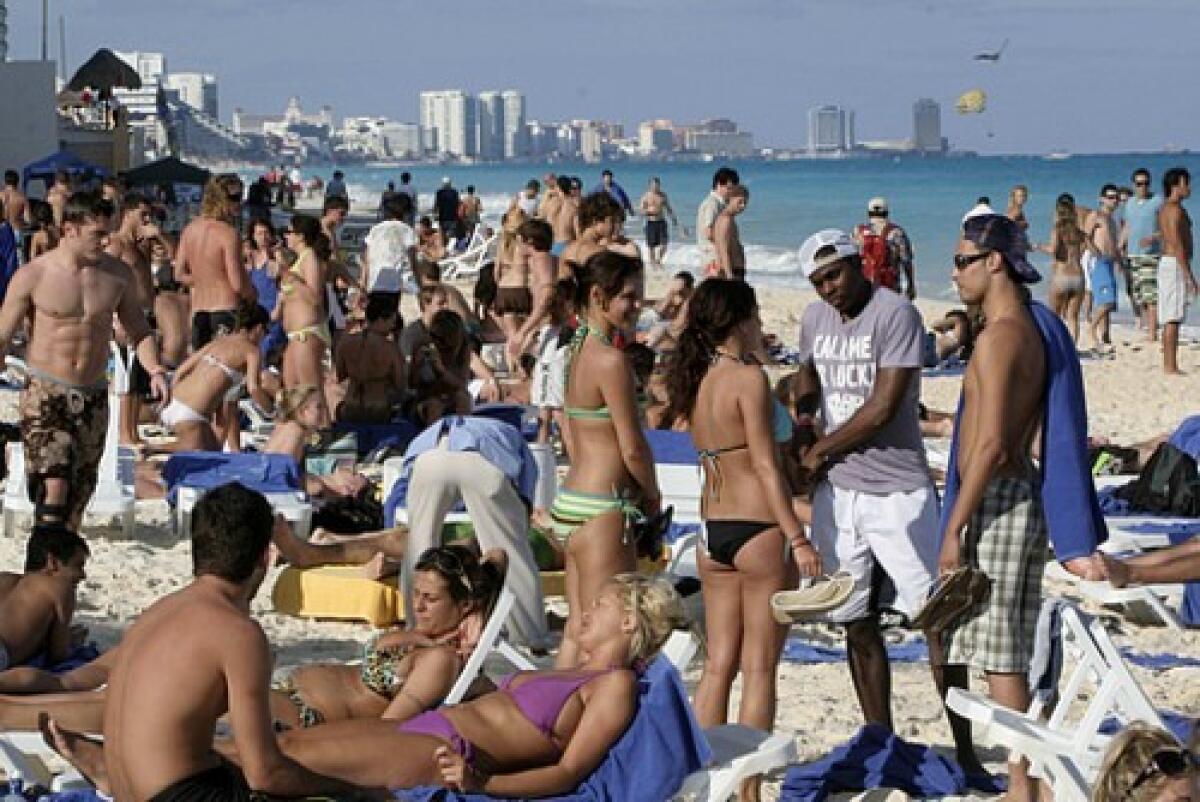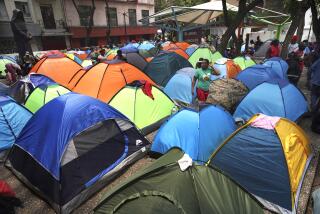Tourists weigh Mexico drug violence

Reporting from Cancun, Mexico — Buried under two months of winter in Buffalo, N.Y., Kim Kramer could take no more.
“I came home and said, ‘I’ve got to get out of here,’ ” said Kramer, a 44-year-old teacher. Two weeks later, she was awash in sunshine here on Mexico’s Caribbean coast, sipping a midday Hurricane and looking pleasantly thawed.
Before Kramer got on the plane to Cancun, though, she made sure to check: Was it dangerous to go there? She reviewed the State Department’s travel advisory for Mexico and decided that the answer for Cancun was no.
“I didn’t see it as a hotbed of violence,” she said.
Mexico’s rampant drug violence has put the issue of safety front and center for would-be vacationers, and put the country’s publicity-sensitive tourism promoters on the defensive. Tens of thousands of foreign visitors are expected to hit Mexican beaches such as Cancun for spring break, which lasts through April.
The University of Arizona has warned students to take extra care if traveling to Mexico during spring break because of “a marked increase in violence recently.”
More than 6,000 people were slain in drug-related violence last year, with daytime shootouts, bodies dumped in piles and beheadings. The grisly news has given pause even to veteran visitors, who have curbed travel to troubled spots on the U.S.-Mexico border, like Tijuana and Ciudad Juarez.
Cancun and other beach resorts have escaped increasingly somber State Department warnings about Mexico. The latest travel alert, issued Feb. 20, describes fearsome conditions on the U.S. border and in northern Mexico, where shootouts have killed bystanders and left U.S. citizens “trapped and temporarily prevented from leaving the area.”
“Robberies, homicides, petty thefts and carjackings have all increased over the last year across Mexico generally, with notable spikes in Tijuana and northern Baja California,” the alert said. Ciudad Juarez, a city on the Texas border where more than 1,600 people were killed last year, is of “special concern.”
The violence stems from feuds among rival Mexican drug traffickers and their confrontations with the police and army. It does not appear to be directed against tourists.
Mexican officials say their country is safe for travelers, but they fear more bad news could batter tourism, one of Mexico’s top sources of foreign income and a sector that has been growing despite the bad news and bad economy.
During a visit to Cancun last month, the Mexican tourism minister, Rodolfo Elizondo, scolded the news media, saying the focus on crime was hurting the nation’s image. Officials have tried to minimize the damage by noting that killings have been concentrated in three states: Chihuahua, Sinaloa and Baja California.
Mindful of Mexico’s image troubles, promoters in the Cancun area are turning to a novel tactic: Don’t mention what country it’s in. Officials say they will downplay Mexico in advertising the beach zone, which has been relatively untouched by the violence.
“The Mexico brand, in terms of tourist marketing, has weakened,” Sara Latife Ruiz, tourism secretary for the surrounding state of Quintana Roo, told the Reforma newspaper.
“This wave of insecurity has been a blow.”
Tourism earnings grew by 3.4% last year, to $13.3 billion, despite the violence and global economic downturn, according to figures from the federal government. Mexico drew 22.6 million foreign visitors, an increase of 5.9%.
Mexico could benefit from belt-tightening in the U.S. by offering travelers relative proximity and, for the moment, a tantalizing exchange rate: around 15 pesos to the dollar.
“For Cancun, it’s ideal,” said Jesus Almaguer Salazar, president of the Cancun Hotel Assn.
Hotels in Cancun, the country’s top beach resort, expect nearly 1 million foreign and Mexican visitors during the 10 weeks of spring break. The largest number of foreigners come from California. In late February, occupancy was about 90% and bookings normal, Almaguer said.
It’s hard to break a tradition as durable as spring break in Cancun. The flip flop-wearing college students are returning -- though many only after persuading parents who are more jittery than ever about Mexico.
“They said, ‘Stay in the resort. Don’t go downtown,’ ” said Cody Seguin, 20, a university student from Toronto.
On a recent day, he and two friends ditched the parental warnings and ventured downtown. They sipped beer and Coke at a market while other vacationers shopped for mementos, all without incident.
“When you get here, everybody’s going downtown,” Seguin said. “And coming back safe.”
More to Read
Sign up for Essential California
The most important California stories and recommendations in your inbox every morning.
You may occasionally receive promotional content from the Los Angeles Times.










